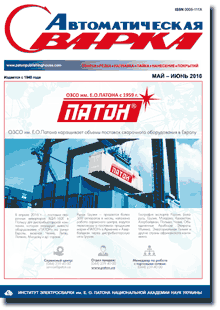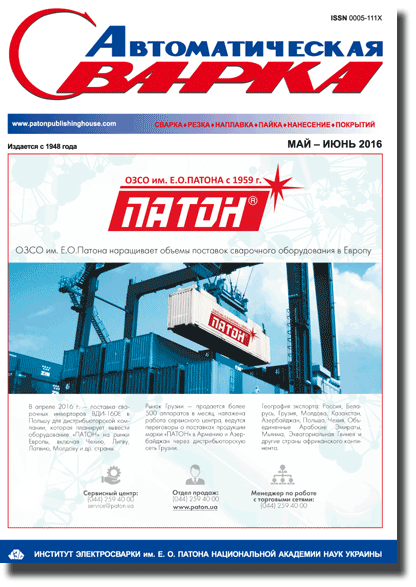| 2016 №06 (21) |
DOI of Article 10.15407/as2016.06.22 |
2016 №06 (23) |

Avtomaticheskaya Svarka (Automatic Welding), #6, 2016, pp. 141-144
Electron beam 3D-deposition of titanium parts
S.V. Akhonin, E.L. Vrzhizhevsky, V.Yu. Belous And I.K. Petrichenko
E.O. Paton Electric Welding Institute, NASU 11 Kazimir Malevich Str., 03680, Kiev, Ukraine. E-mail: office@paton.kiev.ua
Abstract
At present 3D-printing and additive technologies are given a lot of attention in research centers all over the world. In connection with the fact that titanium is a reactive metal, electron beam technologies appear to be the most promising for development of the technology of metal 3D-deposition of parts from titanium-based alloys. The work is a study of the possibility of development of electron beam deposition of complex shapes from commercial titanium. Deposition was performed with application of 2-coordinate manipulator and moving work table, the part was formed on a titanium substrate, titanium welding wire of VT1-00 grade was used as filler material. Parts of rectilinear shape of 35 mm height and of cylindrical shape of 45 mm height with 10 mm wall thickness were produced. Deposited layer structures were studied, and absence of metal porosity in cylindrical and rectilinear deposits was noted. Structure of deposited metal layers is similar to that of cast metal of commercial titanium VT1-0. Microhardness of metal of the part produced by electron beam 3D-deposition with application of VT1-00 welding wire corresponds to the level of micorhardness of cast metal of commercial titanium VT1-0. It is shown that electron beam deposition technology allows producing parts of a complex shape from titanium of a homogeneous structure. 4 Ref., 9 Figures.
Keywords: 3d-printing, electron beam 3D-deposition, electron beam, titanium, structure
Received: 19.02.16
Published: 19.07.16
References
- Hideki Kyogoku (2015) The current status and outlook for metal additive manufacturing in Japan. Metal Additive Manufact., 1(3), 31–39.
- Dutta, B., Froes, F.H. (2015) The additive manufacturing (AM) of titanium alloys. In: Titanium powder metallurgy, 447–468. https://doi.org/10.1016/b978-0-12-800054-0.00024-1
- Xiaoqing Wang, Xibing Gong, Kevin Chou (2015) Scanning speed effect on mechanical properties of Ti–6Al–4V alloy processed by electron beam additive manufacturing. In: of 43rd North American Manuf. Res. Institution of SME, Vol. 1, 287–295. https://doi.org/10.1016/j.promfg.2015.09.026
- Whittaker, D. (2015) Development in the additive manufacturing of titanium at PM titanium. Metal Additive Manufact., 1(3), 53–60.
The cost of subscription/purchase order journals or individual articles
| Journal/Currency | Annual Set | 1 issue printed |
1 issue |
one article |
| TPWJ/USD | 384 $ | 32 $ | 26 $ | 13 $ |
| TPWJ/EUR | 348 € | 29 € | 24 € | 12 € |
| TPWJ/UAH | 7200 UAH | 600 UAH | 600 UAH | 280 UAH |
| AS/UAH | 1800 UAH | 300 UAH | 300 UAH | 150 UAH |
| AS/USD | 192 $ | 32 $ | 26 $ | 13 $ |
| AS/EUR | 180 € | 30 € | 25 € | 12 € |
| SEM/UAH | 1200 UAH | 300 UAH | 300 UAH | 150 UAH |
| SEM/USD | 128 $ | 32 $ | 26 $ | 13 $ |
| SEM/EUR | 120 € | 30 € | 25 € | 12 € |
| TDNK/UAH | 1200 UAH | 300 UAH | 300 UAH | 150 UAH |
| TDNK/USD | 128 $ | 32 $ | 26 $ | 13 $ |
| TDNK/EUR | 120 € | 30 € | 25 € | 15 € |
AS = «Automatic Welding» - 6 issues per year;
TPWJ = «PATON WELDING JOURNAL» - 12 issues per year;
SEM = «Electrometallurgy Today» - 4 issues per year;
TDNK = «Technical Diagnostics and Non-Destructive Testing» - 4 issues per year.





